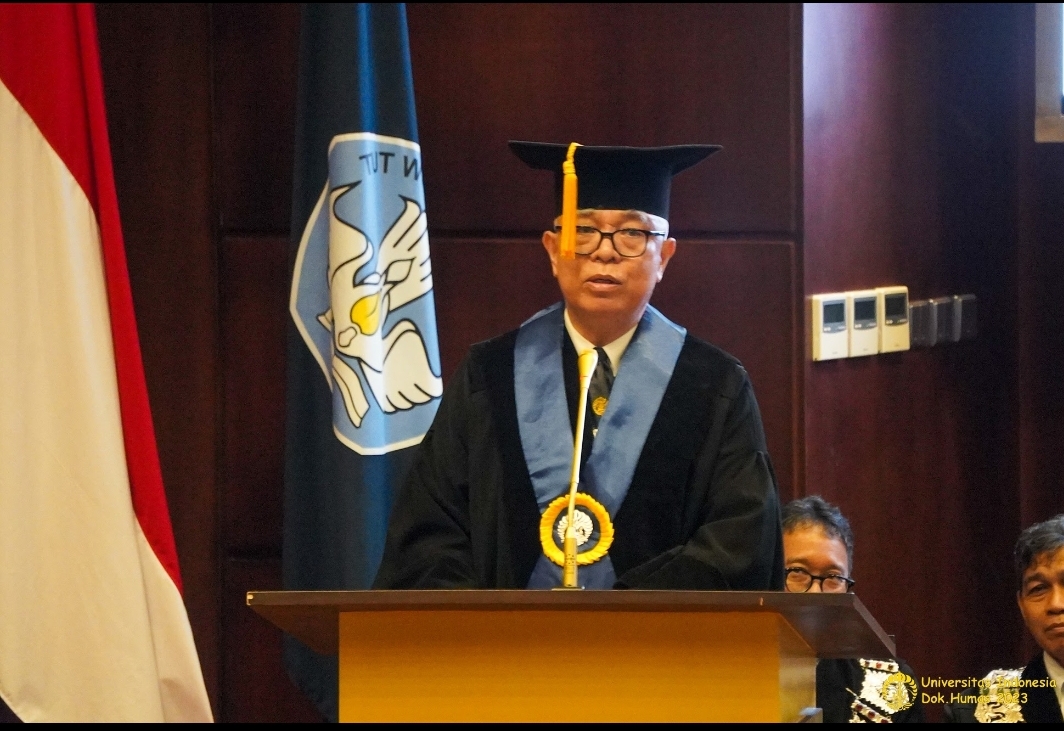In his professorial inauguration speech this morning (Wednesday, 01/03) at the Convention Hall, UI Depok Campus, Prof. Ir. Antony Sihombing, MPD., Ph. D., presented a series of notes from his long journey in tracing two contrasting forms of settlement, namely in urban and rural areas. Through discussing these two forms of settlement, he tries to examine the resilience of these settlements amid increasingly modern and sophisticated urban developments.
“During my long trip to visit several cities and villages, I saw enormous tourism potential, including tourism based on culture, nature, and traditional architecture. Another potential that will support the development and construction of all these potentials is a culture of gotong royong. The government or other related institutions also need to empower this cooperation culture to develop their regions,” said Prof. Antony, Professor of the Faculty of Engineering, Universitas Indonesia (FTUI).
In research conducted since 2000, Prof. Antony distinguishes between the definitions of village and kampung. According to him, the village is a traditional settlement that is not crowded, where the majority of the population works in the agricultural sector. Meanwhile, a village is a traditional settlement that is densely populated, in the middle of a city (urban settlement) where the majority of the work of its residents is in the informal sector, such as street vendors, cart sellers, gardeners, parking attendants, household assistants, office attendants, and many more. who do not have sedentary or odd jobs.
Prof. further Antony said that in various regions in Indonesia, tiny towns where the majority of its citizens work in the agricultural sector, the idea of gotong royong is more widely used in agricultural activities, cultivating rice fields and fields. Like marsirimpa/marsiadapati/marsiurupan in the Batak tribe, it is almost the same as Ngayah (Bali), Baugingan or Baarian (South Kalimantan), Belale in Sambas and Paleo in Krayan (East Kalimantan). Initially, the concept of gotong royong in the area was mostly carried out in terms of working together to cultivate rice fields and gardens. Later, gotong royong developed into mutual assistance in other fields, such as building houses, building irrigation, water sources, natural disasters, and other common needs.
In addition, gotong royong is the key to structuring and developing villages in disaster-prone areas, such as in the highlands, by the beach, by the lake, by the river and so on. “One example is a village located at the foot of Mount Sumbing at an altitude of 1800 m above sea level, namely the village of Dusun Need, better known as Nepal van Java, Magelang district. All houses and other public facilities are built on very steep slopes. Each house is above or below the other house. Narrow paths that motorbikes can only pass also function as terraces for houses. This village was planned and built with local wisdom knowledge and community cooperation which has been passed down from generation to generation,” said Prof. Antony.
The professor inauguration procession was led by UI Chancellor, Prof. Ari Kuncoro was broadcast virtually via the Universitas Indonesia Youtube channel and UI TV. The procession was also attended by Special Staff of the Presidential Staff Office, Ir. Arief Budhy Hardono; Deputy Mayor of Depok, Ir. Imam Budi Hartono, M.Sc.; Nuffic Nesso Indonesia Scholarship Team Coordinator, Ir. Indy Hardono, MBA; Chairman of the Universitas Indonesia Alumni Association (ILUNI UI) for the 2022–2025 period, Dr. Ir. Didit Hidayat A. Ratam, MBA .; Deputy Chancellor IV for Research and Student Affairs at Telkom University Bandung, Dr. Ir. Rina Pudjiastuti, M.T .; and the Head of the National Defense Education and Training Center of the Indonesian Ministry of Defense, Brigadier General TNI Ketut Gede Wetan Pastia, S.E.
Prof. Antony completed his undergraduate education at the Department of Architecture, Faculty of Engineering UI, in 1984. Then, he continued his master’s and doctoral education at The University of Melbourne, Australia with a Master of Planning and Design, the Faculty of Architecture, Planning, and Building (1997) and a Philosophy of Doctor (Ph.D) in Urban Planning and Design, Faculty of Architecture, Planning and Building (2005).
Several of his scientific works in recent years, including Houses With Permeable Walls, A Case Study from Kampong Kwitang, Central Jakarta, The International Journal of Design in Society (2022), Combinatory Spatial Strategies in Home-based Enterprises in Kampung Muka, North Jakarta, The International Journal of Architectonic, Spatial, and Environmental Design (2022), Accessibility and Permeability in Transit Areas. Case Study in Jakarta-Depok Train Station, EVERGREEN Joint Journal of Novel Carbon Resource Sciences & Green Asia Strategy (2022), Avoiding Jakarta: The Housing Preferences Trend of Low-income People in the Suburban Greater Jakarta Metropolitan Area, The International Journal of Design in Society (2002), and The Role of Millennial Urban Lifestyles in the Transformation of Kampung Cities in Indonesia, Environment and Urbanization ASIA (2020).
***
Bureau of Public Communications
Faculty of Engineering, Universitas Indonesia

